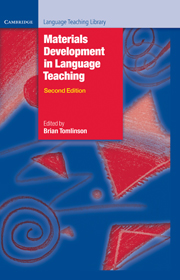Book contents
- Frontmatter
- Contents
- Preface
- Glossary of basic terms for materials development in language teaching
- Acknowledgements
- 1 Introduction: principles and procedures of materials development
- Part A Data collection and materials development
- 2 Using corpora in the language classroom
- 3 Concordances in the classroom without a computer: assembling and exploiting concordances of common words
- 4 Telling tails: grammar, the spoken language and materials development
- Comments on Part A
- Part B The process of materials writing
- 5 A framework for materials writing
- 6 Writing course materials for the world: a great compromise
- 7 How writers write: testimony from authors
- Comments on Part B
- Part C The process of materials evaluation
- 8 The analysis of language teaching materials: inside the Trojan Horse
- 9 Macro- and micro-evaluations of task-based teaching
- 10 What do teachers really want from coursebooks?
- 11 The process of evaluation: a publisher’s view
- Comments on Part C
- Part D The electronic delivery of materials
- 12 Developing language-learning materials with technology
- 13 New technologies to support language learning
- Comments on Part D
- Part E Ideas for materials development
- 14 Seeing what they mean: helping L2 readers to visualise
- 15 Squaring the circle – reconciling materials as constraint with materials as empowerment
- 16 Lozanov and the teaching text
- 17 Access-self materials
- Comments on Part E
- Conclusions
- Recommended reading
- Index
10 - What do teachers really want from coursebooks?
Published online by Cambridge University Press: 09 February 2023
- Frontmatter
- Contents
- Preface
- Glossary of basic terms for materials development in language teaching
- Acknowledgements
- 1 Introduction: principles and procedures of materials development
- Part A Data collection and materials development
- 2 Using corpora in the language classroom
- 3 Concordances in the classroom without a computer: assembling and exploiting concordances of common words
- 4 Telling tails: grammar, the spoken language and materials development
- Comments on Part A
- Part B The process of materials writing
- 5 A framework for materials writing
- 6 Writing course materials for the world: a great compromise
- 7 How writers write: testimony from authors
- Comments on Part B
- Part C The process of materials evaluation
- 8 The analysis of language teaching materials: inside the Trojan Horse
- 9 Macro- and micro-evaluations of task-based teaching
- 10 What do teachers really want from coursebooks?
- 11 The process of evaluation: a publisher’s view
- Comments on Part C
- Part D The electronic delivery of materials
- 12 Developing language-learning materials with technology
- 13 New technologies to support language learning
- Comments on Part D
- Part E Ideas for materials development
- 14 Seeing what they mean: helping L2 readers to visualise
- 15 Squaring the circle – reconciling materials as constraint with materials as empowerment
- 16 Lozanov and the teaching text
- 17 Access-self materials
- Comments on Part E
- Conclusions
- Recommended reading
- Index
Summary
Introduction
If I had been asked what I wanted from coursebooks when I was teaching languages in Japan, England, Singapore and Oman in the last 30 years, my answer would have always been the same: ‘I want coursebooks that are so engaging, inspiring, fl exible and effective that I can just teach without much extra work.’ In reality, I had to adapt materials every time I used them. For example, the Ministry-approved coursebooks often seemed to me so constrained by a syllabus, by rigid methods and by exams, that I found it difficult to make use of them. Global coursebooks from English-speaking countries, on the other hand, seemed impressive, with more fashionable approaches promising success, but their contents seemed too alien to be imported directly into my classrooms. The only time that adaptation was minimal was when I had tailor-made the materials myself. My language-teaching colleagues in all the institutions I worked in often grumbled how language teachers have to work harder compared with other subject teachers, whose content and approaches seemed to remain consistent and who do not have to adapt materials or produce supplements. Even after all these years, my ideal materials only exist in my dreams and my lament seems to echo amongst my colleagues from all over the world. Surely teachers’ needs and wants should have been taken more seriously by now?
From the 1980s to the early 1990s learner variables attracted a lot of attention in the research (Ellis 1994 ; Larsen-Freeman and Long 1991 ). The increasing global need for English as a lingua franca also led to explorations of learner-centred curricula (Johnson 1989 ; Nunan 1988 ) and of needs analysis (Hutchinson and Waters 1987 ). Coursebooks refl ected this change and their blurbs often emphasised that their product was designed to satisfy learners’ needs and interests.
From the late 1990s to 2000s L2 learners’ profiles have become far more complex and learner variables have attracted even more attention (Doughty and Long 2003 ; Ellis 2008 ). The portraits of L2 users these days show incredible diversity (Cook 2002 ; Graddol 1997 , 2006 ). Some learners, for example, may be immigrants at various socioeconomic and linguistic levels, others may be young learners studying content subjects in a target language in their own countries, and others might need different levels of international communication skills in their professions.
- Type
- Chapter
- Information
- Materials Development in Language Teaching , pp. 236 - 266Publisher: Cambridge University PressPrint publication year: 2011
- 16
- Cited by

